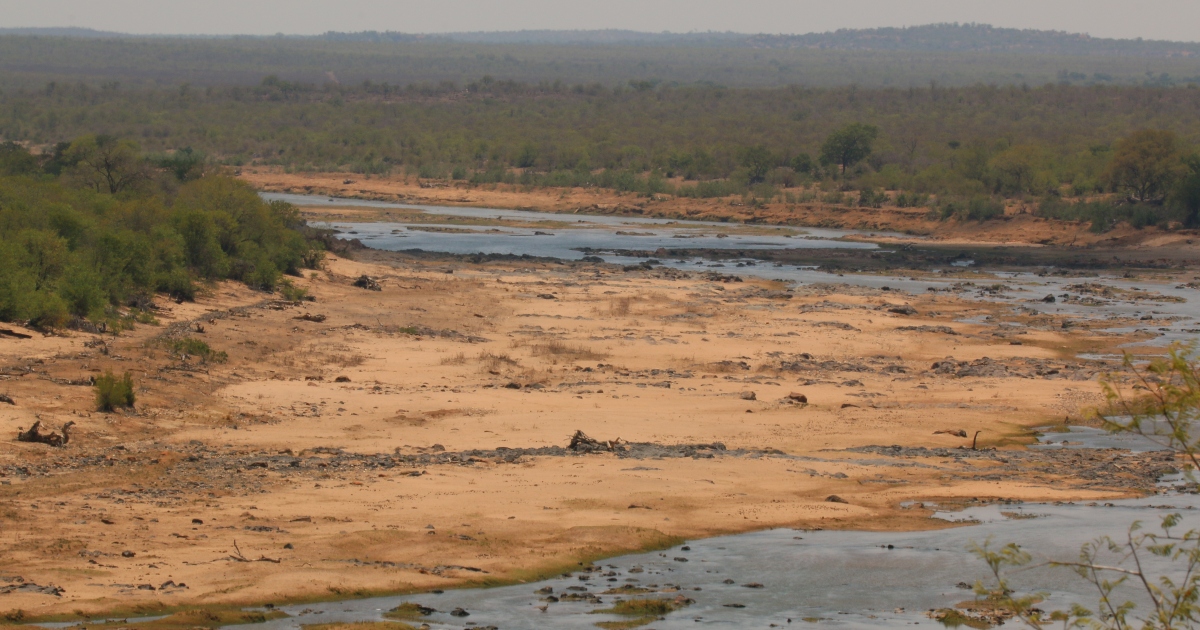Drought is still an underestimated emergency worldwide

Drought in the Olifants River, Kruger National Park, South Africa. Photo: Abspires40/Wikimedia Commons
Drought is a silent killer – this is how Ibrahim Thiaw, Executive Secretary of the United Nations Convention to Combat Desertification (UNCCD), described it. The occasion was the release of the report titled “Drought Hotspots Around the World 2023-2025,” which reviews and analyses the severe droughts that have occurred in various parts of the world from 2023 to 2025. The report also identifies the primary global drought hotspots – i.e., regions that are already, or soon will be, the most severely affected by this natural disaster.
This well-documented report places special emphasis on the regional and national areas most affected by drought. It begins by identifying the two major drivers that have exponentially increased the frequency and persistence of drought conditions in different parts of the world over the past three years: climate change and the El Niño-Southern Oscillation (ENSO) phenomenon. ENSO is a cyclical climatic phenomenon (occurring approximately every 2-7 years) involving a temporary rise in surface water temperatures in the central-southern and eastern Pacific Ocean (El Niño) accompanied by shifts in atmospheric pressure (Southern Oscillation) in the same geographical area. ENSO – and its counterpart, La Niña, which involves cooling of surface ocean waters and lowered atmospheric pressure – has global climatic impacts, causing intense rainfall in some regions and prolonged droughts in others.
The occurrence of this climatic event in 2023 worsened the already apparent consequences of anthropogenic climate change, particularly in the most vulnerable countries, by exposing and exacerbating, as the report states, “existing social, economic, and environmental vulnerabilities.”
The report aims to provide a thorough understanding of these vulnerabilities, as this knowledge is crucial for developing mitigation and preparedness strategies in the rapidly warming world of the coming years.
The identified drought hotspots are numerous and globally dispersed: Eastern and Southern Africa, the Mediterranean, the Amazon Basin, Panama, Mexico, and Southeast Asia. Drought conditions have been critical in all these regions over the past three years, and the severity of their impacts has been exacerbated by existing socioeconomic vulnerabilities.
Eastern and Southern Africa
In Eastern and Southern Africa, prolonged drought has exacerbated pre-existing socioeconomic issues, chronic resource scarcity, and political conflicts, resulting in severe consequences including substantial human losses due to extreme food and water insecurity. “Five consecutive years of failed rainy seasons in Ethiopia, Somalia, and Kenya brought the worst drought in seventy years to the Horn of Africa by January 2023.” A similar situation occurred in southern Africa, where 2024 saw the region’s worst drought in a century. In response, Zambia, Zimbabwe, Malawi, and Namibia all declared national emergencies. These extreme events have brought hunger, displacement, power outages, disease, and disrupted education (particularly for girls, due to entrenched gender inequalities), as well as an increased death toll in many cases.
Between 2023 and 2024, it is estimated that hunger-related deaths were tens of thousands in the region. Tens of millions of domestic animals (especially livestock) also died due to malnutrition and water scarcity, worsening the food crisis in East Africa. In southern Africa, widespread crop failure affected over two million hectares of farmland. In August 2024, the Southern African Development Community reported that 17% of the population – about 68 million people – was in need of food assistance.
Drought also had a dramatic impact on energy infrastructure in Africa, particularly in southern countries where hydropower is a major energy source. In April 2024, the Zambezi River, which feeds the enormous Kariba Dam that provides power to both Zambia and Zimbabwe, was at just 20% of its mean capacity. By September 2024, this figure had dropped to just 7%. In response, both countries increased their use of coal and began to ration electricity, causing further economic disruption.
Given the poor sanitary conditions, especially in rural areas, the prolonged water shortages also increased the risk of infections, both due to the inability to maintain personal hygiene and the consumption of contaminated water, often drawn directly from rivers and underground wells.
Another, perhaps less obvious, consequence of the drought has been a sharp increase in forced child marriages, which are sometimes seen as the only economic option for many families. This has resulted in increased school abandonment and more widespread gender-based violence in several drought-stricken African countries.
The Mediterranean
The Mediterranean Basin is a hotspot of climate change. The region is particularly susceptible to the effects of global warming, such as rising temperatures (projected to increase by 2-3°C by 2050 and 3-5°C by 2100) and declining rainfall. Combined with human factors such as population growth and urbanisation, these environmental pressures further heighten the risk of water scarcity and desertification.
Although droughts have always occurred in the Mediterranean region, their frequency and intensity has increased since the 1950s. Certain areas, such as “Sicily, Cyprus, Morocco, Algeria, Tunisia, southern Spain and Portugal, parts of Syria, and southern Turkey,” are expected to become increasingly arid and may face expanding desert-like conditions, with “significant human and economic losses” becoming more likely.
In Mediterranean countries recently hit by drought, impacts on key economic sectors such as agriculture and farming have been especially severe. In Morocco, where drought has struck for six consecutive years, meat and grain production has been severely impacted, resulting in economic losses and rising food prices. Spain experienced a drought from 2022 to 2024, which led to shortages of water for domestic, industrial, and agricultural uses, as well as major crop failures. One particularly notable global consequence was the drop in olive oil availability, explained by the fact that Spain is the largest European exporter and one of the world’s leading producers.
The Amazon
The Amazon plays a crucial role in regulating the global carbon cycle. Therefore, its growing vulnerability to drought is a cause for particular concern, as drought can significantly disrupt its complex ecosystems, with “lasting impacts on the global carbon cycle,” as outlined in the report. Moreover, scientists are increasingly concerned that “ongoing drought could change the Amazon rainforest from a net carbon-neutral state to a carbon source.” Drought intensifies ongoing environmental degradation within the region’s forest ecosystem. The 2023-2024 drought in the Amazon region is considered to be unprecedented in terms of its scale and severity: it affected as many as nine countries and likely was the most serious and widespread drought ever recorded in the region.
The impacts were manifold, with one of the most visible being the sharp reduction in river flow. As waterways are the main transportation routes in the forest, many communities struggled, or were unable, to access essential goods and services. Reduced river flow also impacted fishing, which is a primary source of sustenance for many local communities. Moreover, mass fish die-offs contaminated waters, leading to severe shortages of clean water.
In an effort to address the transportation challenges in the region, the Brazilian government has pledged to construct new roads and highways across the Amazon. However, research shows that building new roads can have the unintended consequence of increasing illegal deforestation, as these new routes provide access to remote forest areas. Deforestation and drought interact in a feedback cycle: “Deforestation decreases the amount of evapotranspiration generated by photosynthesis, which reduces the amount of rainfall both locally and across the South American continent. The resulting drought stresses plants and increases the risk of fire, further driving deforestation.”
Southeast Asia
This region is considered to be one of the areas most vulnerable to climate change. Here, the effects of El Niño are similar to those of climate change: rising temperatures and reduced rainfall. Many countries in the region are major global food exporters and have experienced severe economic impacts of drought. Vietnam, the world’s top producer of Robusta coffee, reported a 20% yield drop in 2023–2024. Similarly, Thailand, which is the world’s second-largest sugar producer, saw a 12.4% drop in yields compared to the previous year.
Another direct consequence of the drought in the region was saltwater intrusion, which severely impacted the Mekong Delta in Vietnam in early 2024. This phenomenon, exacerbated by the drought, drastically reduced water availability for domestic use, destroyed entire rice crops (on which local populations rely heavily), and disrupted shrimp farming, a key economic activity in the area. With the dry season starting earlier than usual, saltwater intrusion occurred again in early 2025, surpassing the levels recorded the previous year.
Panama and Mexico
The impacts of drought are wide-ranging. The extreme drought event that hit Panama between 2023 and 2024 caused a logistical crisis at the Panama Canal, a key global shipping route. Reduced water levels forced the local government to impose daily restrictions on the passage of large cargo ships, resulting in a 36% drop in canal traffic between late 2023 and early 2024.
Mexico has also faced severe drought in recent years. Between 2022 and 2023, 67% of the country was affected by drought. Here, too, the climatic extreme event interacted with human pressures such as rapid population growth, urbanisation, and the overuse of water resources.
Furthermore, Mexico is currently dealing with a political issue exacerbated by drought: under a 1944 treaty, the country is obliged to deliver to the United States a large volume of water from the Rio Grande basin every five years. The next delivery is due in 2025, but Mexico has thus far supplied less than 30% of the required amount. When the previous deadline approached in 2020, communities in the northern region, which depend directly on the Rio Grande, strongly opposed honouring the treaty, leading to violent clashes. Today, again, local politicians are opposing the fulfilment of the treaty, arguing that national security must come first, especially during a national emergency caused by the climate crisis.
Preparedness is key
Alongside climate change, whose impacts are becoming increasingly difficult to mitigate, other factors influence drought risk. These include the pace of the sustainability transition, globalisation, demographic dynamics, and innovation. At the same time, projected increases in urbanisation and population growth will boost water demand in the coming decades, reshaping the global drought risk landscape.
The report’s final message is clear: in such a complex context, societies and countries must work to build resilience to drought risk. This requires investment in the restoration and protection of ecosystems, responsible water management, and equitable access to water resources.
Moreover, reducing the wasteful use of water resources is key to making the expected population growth sustainable in the context of a changing climate and increasing resource scarcity. Agriculture and industry offer the greatest opportunities for improvement through the application of innovative techniques and sustainable practices like Nature-Based Solutions.
Finally, governments must adopt national drought plans based on “proactive mitigation measures, clearly defined roles and responsibilities, and action triggers based on continuous monitoring.” Drought is a slow-moving disaster, so the only effective response is to be proactive. We must shift from reacting to emergencies to enhancing preparedness by raising awareness, engaging communities in solutions, and adapting to the new environmental reality.









